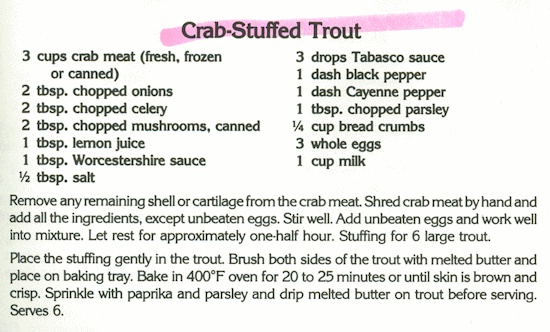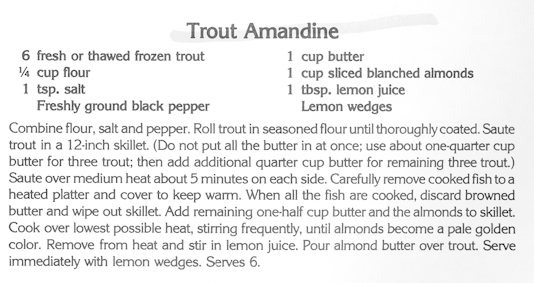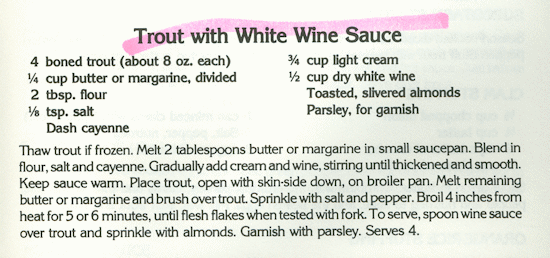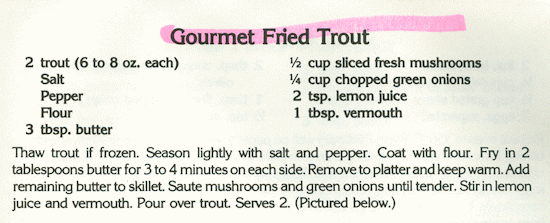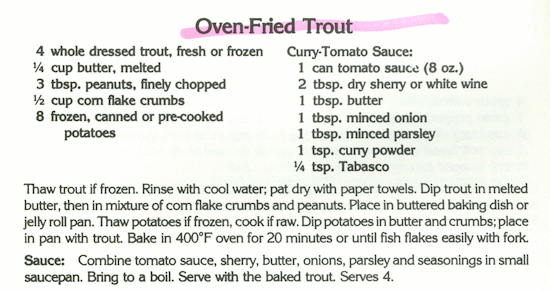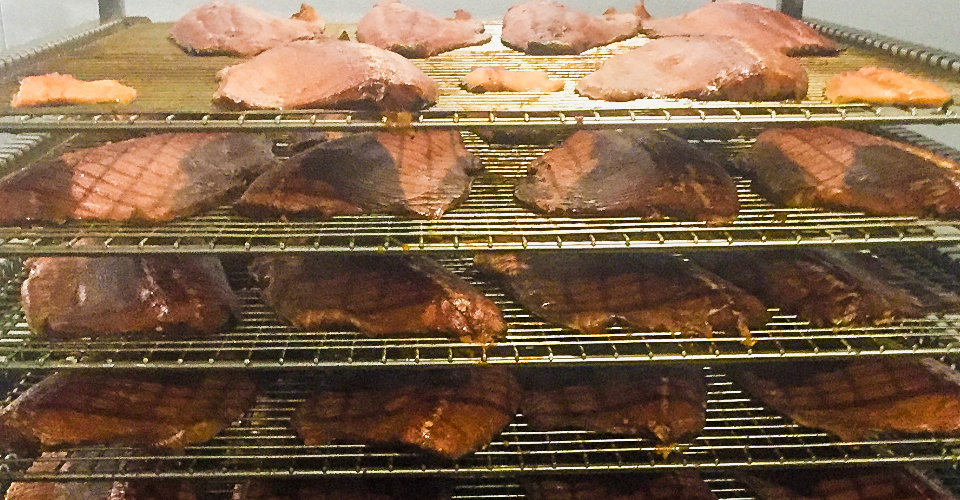 Trout…for healthy eating!
Trout…for healthy eating!
An important plus to its many excellent qualities is the fact that few foods are as nutritious as trout.
Fish has been shown to improve human health by lowering serum cholesterol and triglyceride values thereby helping prevent or decrease coronary heart disease. In addition, trout is an excellent source of protein, both in quality and quantity. Fish protein contains all nine of the essential amino acids required by man and ranks second only to egg protein in quality.
When compared with beef, pork and chicken, fish is an equivalent or better source of most of the vitamins, especially A and D, thiamin, riboflavin, pyrodixine, cyanocobalimine, niacin and choline. And, the calcium content of fish is up to eight times greater than beef, pork and chicken. At the same time, unless it’s been smoked or salted, trout has a low sodium content. People on low-sodium diets due to high blood pressure or cardiac problems are generally urged to eat fresh fish because of its low sodium content.
Trout also contains an impressive array of micro minerals, including iron, manganese, zinc, copper, iodine, selenium and floride. Selenium is one of the more recently discovered trace minerals that is essential to man and it appears to help prevent some forms of cancer. It has been suggested we should increase our selenium intake and trout has a higher selenium content than almost all other food sources.
Whether fresh or frozen, trout is an excellent food and making it a regular part of your diet can improve your health. Trout’s high-quality, easily digested proteins help build and repair daily wear and tear on body tissues. An average serving of trout supplies enough animal protein to satisfy the individual daily requirement.
As well as good food for the body, trout is also good for the waistline. Calorie-conscious dieters should know that when compared with average cuts of pork and beef, trout has about a third to one-half the number of calories.
So, to eat healthy, lose weight and enjoy excellent, delicious food…Try Trout!
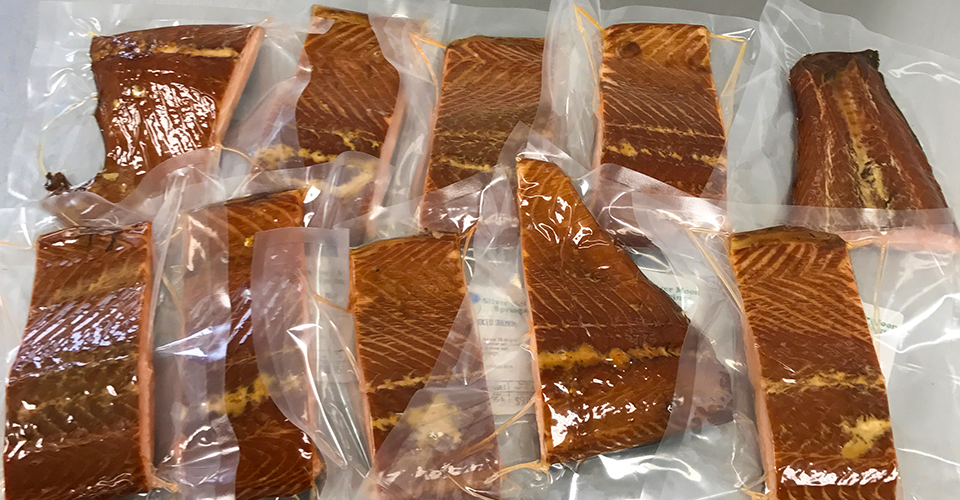
Handling How-To’s…
Fresh Trout…may be kept in the refrigerator at an even, cold temperature for one to five days.
Packaged Frozen Trout…store at 0 F or below.
To Freeze Trout…wrap in portion-size packages, as air-tight as possible. Freeze as quickly as possible. Store at 0 F or below. (Success in freezing fresh trout depends a great deal on the handling the trout receives from stream or lake to freezer. Live trout should be cleaned as soon as possible after being taken from the water; then kept very cold, either in refrigerator or packed in ice, until ready to freeze.)
To Thaw Trout…allow to thaw before cooking, four to six hours in refrigerator; or two to three hours at room temperature. Do not “speed” thaw trout in water.
Microwave Method to Thaw…place trout in shallow glass baking dish, cover with plastic wrap. Microwave at DEFROST (40% power) for 50 seconds. Turn, cover and microwave another 1 1/2 minutes, or until trout is pliable on outside, yet icy in center. Let stand, covered, three minutes. (Times are for one trout.)
Once trout thaws, it should be used immediately. NEVER REFREEZE TROUT AFTER THAWING…this will impair flavor.
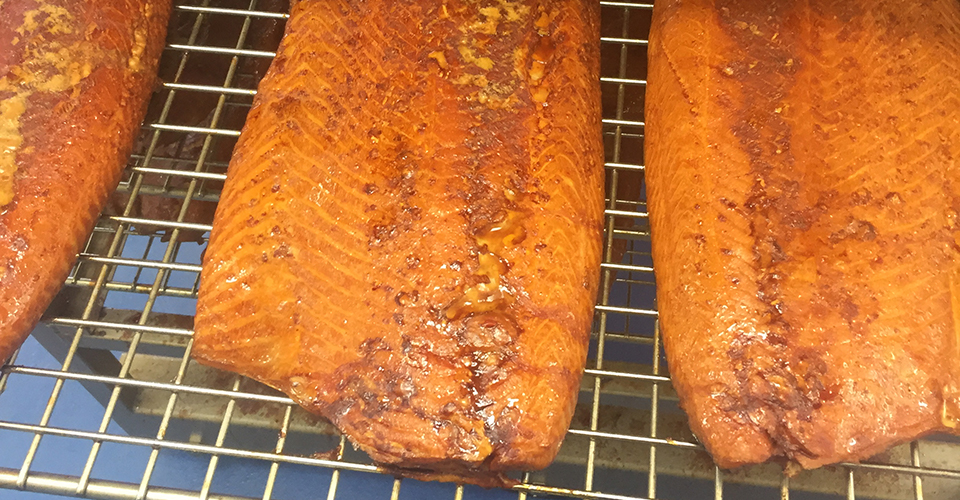
Preparation Pointers…
Baking…To preserve flavor and moisture in the flesh, bake trout (skin side down) at a moderately high temperature, 400 to 425 F, for the shortest period of time. Enhance moistness and flavor with a seasoned oil; or many baked recipes call for sauces or stuffings. Test for doneness by probing with a fork. Do not turn.
Broiling…Never place trout closer than 4 inches from the source of the heat. Baste well with a basting oil or sauce before and during cooking. Broil (skin side up) 8 to 10 minutes, depending on thickness. Do not turn.
Grilling…Season to taste, or baste trout with selected sauce before and during grilling. Place trout on grill approximately 4 to 6 inches from hot charcoal. Cooking time varies with size of trout and temperature of grill. Allow about 1 to 2 minutes per ounce of trout. Cook naturally folded, not open, even if boned, unless otherwise directed. To turn, trout will roll easily on its rounded back. To remove from grill, slide spatula under trout from head to tail. To test for doneness, check inside that no pink is left. Trout that is done will flake easily with a fork. (Note: to help prevent sticking, spray grill with a non-stick product.)
Pan Frying…Use a small amount of hot vegetable oil, about 1/8 inch, in heavy fry pan. Roll in coating and fry lightly, or saute, at a moderate temperature, until browned on one side. Place meat-side down first. Turn and brown second side. Do not overload pan. Trout is done when it flakes easily with a fork.
Deep Frying…Fill fryer about half full with oil. Use light breading (flour and/or cornmeal) or thin batter.
(A thick batter absorbs fat.) Fry in deep oil at 325 to 350 F until trout is brown and flakes easily with a fork.
Microwave How To…
Cook, rinse and pat dry. Place trout skin-side down in shallow glass baking dish. Cover with plastic wrap. Microwave at HIGH 2 1/2 to 3 1/2 minutes. Let stand, covered, 2 minutes to finish cooking. (Times for 1 trout.) Trout should flake easily with a fork when done.
Trout Tips…
Do Not Scale Trout…Removal of the tiny scales also removes the thin coat of natural jelly around the scales that allows the trout to be breaded without using any type of liquid.
Don’t Overcook…Trout should be moist and fork-tender. Overcooking dries out and toughens the fish. Trout is done when it flakes easily when probed with a fork.
Recipes…
Here are some of our favorite recipes for cooking trout. These recipes are adapted from “Trout,” A Collection of Recipes from the U.S. Trout Farmers Association.
Enjoy!

